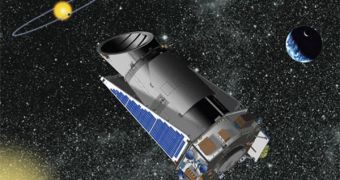Following the successful jettisoning of its dust cover a few weeks ago, NASA's Kepler Space Telescope has now begun its actual mission of searching for other Earth-like planets in our galaxy. The time that passed between the ejection of the cover and the beginning of the actual observations was used by mission controllers and engineers to calibrate the sensitive instruments aboard the observatory, so that they should know exactly what errors could occur in the observations, and how to compensate for them.
“Based on what we already know, the universe is going to turn out to be [a] chock full of habitable planets (i.e. Earth-like worlds), and therefore life is likely to be widespread,” the author of “The Crowded Universe,” Carnegie Institution in Washington Astrophysicist Alan Boss said in February, while speaking at the annual meeting of the American Association for the Advancement of Science (AAAS).
The Kepler Space Telescope (KST) was designed specifically to be used for planet-hunting purposes, and features very delicate instruments, able to detect minute variations in the glow of distant stars. These variations may be a hint that another celestial body (as in a planet, moon or asteroid) has moved in front of the star, between it and Kepler. Named after the German astronomer Johannes Kepler, the observatory was developed by the Ball Aerospace & Technologies Corp., and the science that comes out of it is analyzed and processed at NASA's Ames Research Center, in Moffett Federal Airfield, California.
“Kepler's first glimpse of the sky is awe-inspiring. To be able to see millions of stars in a single snapshot is simply breathtaking,” Kepler's Program Executive Lia LaPiana, from the space agency's headquarters in Washington, DC, explained. The 100-square-degree portion of the sky that Kepler was built to investigate houses an estimated 14 million stars, of which about 100,000 have been already designated as possible centers of gravity for Earth-sized planets. KST sent its first images back on April 16th, shortly after the cover was jettisoned.

 14 DAY TRIAL //
14 DAY TRIAL //